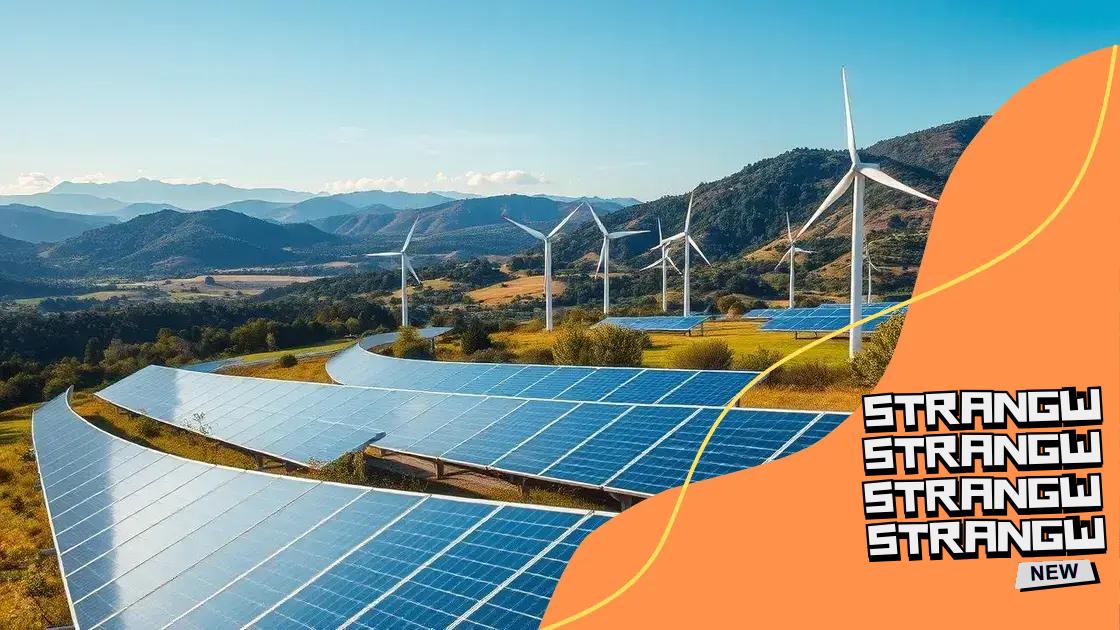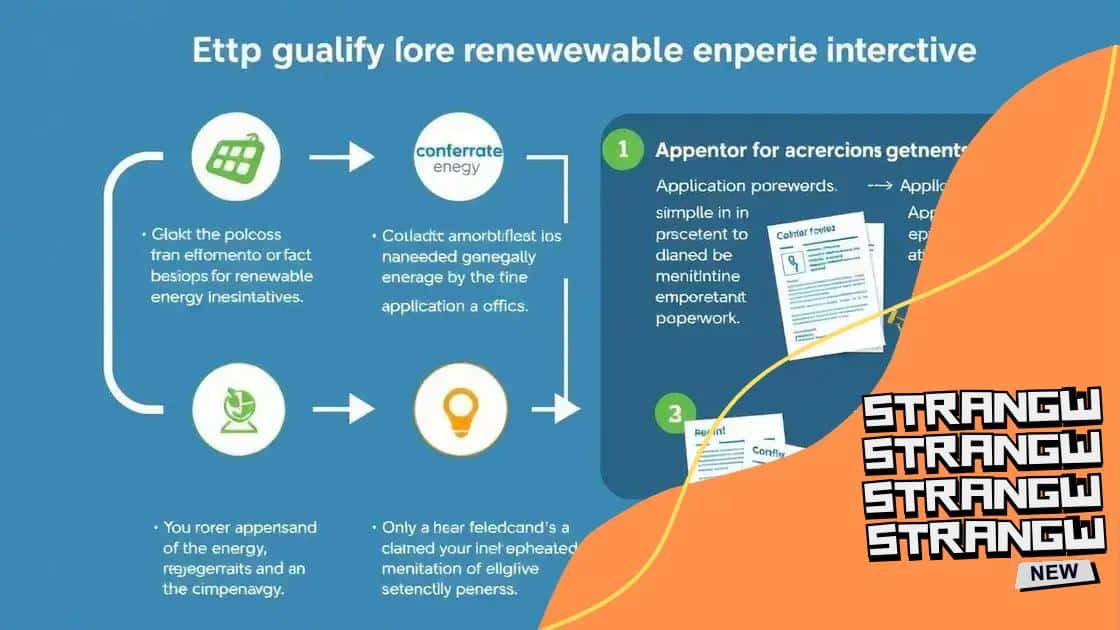Renewable energy incentives: unlock savings today

Renewable energy incentives, including tax credits and rebates, significantly reduce installation costs and encourage the adoption of clean energy solutions, resulting in long-term savings on energy bills.
Renewable energy incentives offer individuals and businesses a chance to save money while adopting sustainable practices. Have you ever wondered how these incentives work and how they could benefit you? Let’s dive deeper into this exciting topic.
Understanding renewable energy incentives
Understanding renewable energy incentives is essential for anyone looking to reduce their energy costs and support sustainable practices. These programs are designed to encourage the use of clean energy sources, helping both homeowners and businesses switch to more environmentally friendly options. By learning about these incentives, you can find ways to save money while contributing to a healthier planet.
What are renewable energy incentives?
Renewable energy incentives are financial aids or policies provided by governments or organizations to promote the adoption of renewable energy sources. These might include tax credits, rebates, or grants available for solar, wind, or geothermal energy systems.
- Tax credits to reduce your taxable income
- Cash rebates for installing renewable energy technologies
- Low-interest loans to finance renewable energy projects
- Grants for community-based renewable energy initiatives
By utilizing these incentives, you can offset the initial costs of installing renewable energy systems, making it more affordable to transition away from fossil fuels.
How do these incentives work?
Each incentive has specific eligibility criteria and application processes. Some incentives are available at the federal level, while others can be accessed through state or local programs. It is important to research what options are available in your area. For example, federal tax credits may cover a percentage of the installation costs for solar panels, allowing homeowners to save a significant amount over time.
Additionally, many states offer their own incentives, such as renewable portfolio standards, which require utilities to obtain a certain percentage of their energy from renewable sources. This creates a marketplace for renewable energy, further enhancing the overall impact of these incentives.
The importance of renewable energy incentives
Renewable energy incentives play a crucial role in combating climate change and promoting sustainable energy practices. By supporting renewable energy development, these programs help reduce greenhouse gas emissions, decrease reliance on non-renewable resources, and stimulate job creation within the green energy sector. It’s clear that the more we invest in renewables, the greater the potential for future savings and environmental benefits.
In conclusion, understanding renewable energy incentives can open up new opportunities for savings while significantly contributing to a healthier environment. Whether you’re a homeowner or a business owner, exploring these options can bring both financial and ecological benefits. Taking the time to learn about what’s available could lead you to a brighter, more sustainable energy future.
Types of incentives available
There are various types of renewable energy incentives available to support individuals and businesses in adopting clean energy solutions. Understanding these options is crucial to maximize your benefits and savings.
Tax Credits
Tax credits are one of the most common forms of incentives. They reduce your total tax liability based on a percentage of your renewable energy system’s cost. For instance, the federal solar tax credit allows you to claim up to 26% of your solar installation costs.
- Federal Investment Tax Credit (ITC) for solar and wind energy
- State-specific tax credits that may provide additional savings
- Local programs offering incentives based on energy efficiency
These credits can significantly offset the upfront costs of installing renewable technologies.
Rebates
Rebates are direct cash payments provided after the installation of renewable energy systems. Many states and utility companies offer these to encourage residents to make the switch. Rebates can help lower the effective cost of systems, making them more accessible.
- Utility company rebates for energy-efficient home improvements
- State-sponsored rebate programs for solar panel installations
- Community projects focused on renewable energy solutions
Taking advantage of these rebates can make the investment in renewable energy far more enticing.
Grants and Loans
Grants are funds that do not need to be repaid, making them an attractive option for funding renewable energy projects. Various organizations, including the federal government and nonprofits, provide grants to support community-based initiatives.
- Federal grants for renewable energy research and development
- State programs offering low-interest loans for home energy efficiency upgrades
- Local grants focused on environmental conservation efforts
These financial options create opportunities for both residential and commercial buildings to implement renewable energy successfully.
Each type of incentive has unique qualifications and application processes, so it’s essential to research what applies to your situation. By understanding and utilizing the various types of incentives available, you can make informed decisions that benefit both your wallet and the environment.
How to qualify for renewable energy incentives

Qualifying for renewable energy incentives is important for anyone looking to save money while contributing to a greener planet. There are several criteria that individuals and businesses usually need to meet to take advantage of these incentives.
Eligibility Requirements
The eligibility requirements for renewable energy incentives can vary based on the type of incentive and the specific program. Generally, you will need to ensure that your renewable energy system meets certain technical standards. For instance, systems must often be installed by certified professionals and meet local building codes.
- Installation by a licensed contractor
- Compliance with local and state regulations
- Use of certified equipment and materials
Being aware of these requirements before installing a renewable energy system can help you avoid delays in receiving your incentives.
Application Processes
To qualify, you typically need to complete an application process. This can involve submitting documentation that proves your installation meets all requirements. It’s essential to keep track of all necessary documentation, such as receipts, installation reports, and tax forms. Submitting a complete application can expedite your claims for incentives.
- Gather necessary paperwork concerning your renewable energy system
- Complete all required forms accurately
- Submit your application within specified deadlines
Understanding the application process will help you navigate the system efficiently and enhance your chances of receiving benefits.
Stay Informed
Staying informed about changes in incentive programs is crucial. Policies can change based on government regulations and funding availability. Regularly check with your local energy authority or the database of state incentives for renewables (DSIRE) to find up-to-date information regarding available programs and changes.
By remaining proactive, you can make the most of the incentives available to you.
In summary, knowing how to qualify for renewable energy incentives involves understanding eligibility requirements, navigating application processes, and staying updated on program changes. This knowledge is key to making a successful transition to renewable energy.
Impact of incentives on energy costs
The impact of incentives on energy costs can be substantial for both homeowners and businesses. These incentives encourage the adoption of renewable energy solutions, leading to reduced energy expenses over time. By understanding this impact, individuals can make informed decisions about their energy sources.
Immediate Savings
One of the most significant advantages of renewable energy incentives is the immediate savings they can provide. For instance, tax credits or rebates can lower the upfront costs of installing solar panels or wind turbines. This reduction makes renewable energy systems more affordable.
- Tax credits can reduce the overall cost of installation.
- Rebates provide cash back after the installation.
- Financing options can lower monthly payments for energy projects.
With these savings, many property owners find that their return on investment (ROI) improves significantly, making renewable energy an attractive choice.
Long-Term Cost Reductions
Incentives not only reduce initial expenses but can also lead to long-term reductions in energy costs. Once a renewable energy system is in place, users often experience lower utility bills due to reduced reliance on traditional energy sources. They may also benefit from net metering programs, which allow them to sell excess energy back to the grid.
Lower utility costs translate to savings that can vary depending on energy consumption and local rates. In many cases, customers have reported savings of 20% to 50% on their energy bills after switching to renewable sources.
Incentives Drive Market Growth
The awareness surrounding renewable energy incentives also drives market growth. As more people take advantage of these offers, the demand for renewable technologies increases. This, in turn, often leads to lower prices for energy systems and components over time, further decreasing costs for new adopters.
Overall, incentives play a key role in shaping the future of energy consumption. Understanding their impact on energy costs helps consumers make wise choices, ultimately contributing to both financial savings and environmental benefits.
Future of renewable energy incentives
The future of renewable energy incentives looks promising as the world increasingly shifts towards sustainable energy sources. Governments and organizations recognize the need for broad support to combat climate change and promote green solutions.
Growing Government Support
Many governments are expanding their incentive programs to facilitate the transition to renewable energy. This support often includes better tax incentives, grants, and subsidies aimed at reducing the costs of installations. For example, states are working to increase solar rebates, making it more affordable for residents to install solar panels.
- Increased funding for renewable energy projects
- New policies aimed at promoting clean energy technologies
- Partnerships with private sectors to drive innovation
This growing government backing will likely lead to more accessible renewable options for consumers in the future.
Innovative Technologies
Innovation will also shape the future of renewable energy incentives. As technology advances, energy systems become more efficient and cheaper to install. For instance, improvements in battery storage technologies make it possible to store excess energy generated from solar panels.
These innovations can attract more incentives as they promise better performance and lower costs.
Increased Awareness and Participation
Public awareness regarding the importance of renewable energy is rising, leading to greater participation in incentive programs. More individuals and businesses are realizing the long-term cost benefits of switching to renewable energy sources. This trend encourages governments to provide even more robust incentives to sustain this momentum.
Educational campaigns about the benefits of renewable energy will likely encourage more homeowners and businesses to participate in incentive programs.
Overall, the outlook for renewable energy incentives is evolving positively. With increasing government support, technological advancements, and heightened public awareness, these incentives are set to play a key role in making clean energy an accessible and cost-effective option for all.
The landscape of renewable energy incentives is evolving, offering exciting possibilities for consumers and businesses alike. As these incentives grow, they encourage more people to invest in clean energy solutions. With ongoing government support, innovative technologies, and increasing public awareness, the future appears bright for renewable energy. By understanding and taking advantage of these incentives, you can contribute to a greener environment while saving money on energy costs.
FAQ – Frequently Asked Questions about Renewable Energy Incentives
What types of renewable energy incentives are available?
Incentives include tax credits, rebates, grants, and low-interest loans to help offset the costs of renewable energy installations.
How can I qualify for renewable energy incentives?
To qualify, ensure your renewable energy system meets technical standards and comply with local regulations. You may also need to complete an application process.
What impact do renewable energy incentives have on energy costs?
Incentives can significantly reduce upfront installation costs and lead to long-term savings on your energy bills, allowing for a quicker return on investment.
What is the future outlook for renewable energy incentives?
The future looks promising, with growing government support, technological advancements, and increased public awareness driving more participation in incentive programs.





